
Hemiptera is an order of insects, commonly called true bugs, comprising over 80,000 species within groups such as the cicadas, aphids, planthoppers, leafhoppers, assassin bugs, bed bugs, and shield bugs. They range in size from 1 mm (0.04 in) to around 15 cm (6 in), and share a common arrangement of piercing-sucking mouthparts. The name "true bugs" is often limited to the suborder Heteroptera.
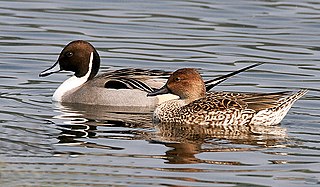
The pintail or northern pintail is a duck species with wide geographic distribution that breeds in the northern areas of Europe and across the Palearctic and North America. It is migratory and winters south of its breeding range to the equator. Unusually for a bird with such a large range, it has no geographical subspecies if the possibly conspecific duck Eaton's pintail is considered to be a separate species.

Helicoverpa zea, commonly known as the corn earworm, is a species in the family Noctuidae. The larva of the moth Helicoverpa zea is a major agricultural pest. Since it is polyphagous during the larval stage, the species has been given many different common names, including the cotton bollworm and the tomato fruitworm. It also consumes a wide variety of other crops.
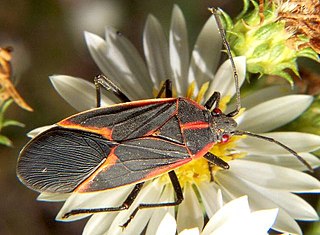
The boxelder bug is a North American species of true bug. It is found primarily on boxelder trees, as well as maple and ash trees. The adults are about 13 millimetres (0.51 in) long with a dark brown or black coloration, relieved by red wing veins and markings on the abdomen; nymphs are bright red. In 2020, this species invaded Chile, thus becoming an invasive species.

Anasa tristis is a species of bug in the family Coreidae. It is a major pest of squash and pumpkins, found throughout North America, and is a vector of the cucurbit yellow vine disease bacterium. These bugs can emit an unpleasant odor when disturbed. It is commonly known as the squash bug but shares this name with certain other species.
Blissus leucopterus, also known as the true chinch bug, is a small North American insect in the order Hemiptera and family Blissidae. It is the most commonly encountered species of the genus Blissus, which are all known as chinch bugs. A closely related species is B. insularis, the southern chinch bug.

Phyllophaga is a very large genus of New World scarab beetles in the subfamily Melolonthinae. Common names for this genus and many other related genera in the subfamily Melolonthinae are May beetles, June bugs, and July beetles. They range in size from 12 to 35 mm and are blackish or reddish-brown in colour, without prominent markings, and often rather hairy ventrally. These beetles are nocturnal, coming to lights in great numbers.

The brown marmorated stink bug is an insect in the family Pentatomidae, native to China, Japan, Korea and other Asian regions. In September 1998 it was collected in Allentown, Pennsylvania, where it is believed to have been accidentally introduced. The nymphs and adults of the brown marmorated stink bug feed on over 100 species of plants, including many agricultural crops, and by 2010–11 had become a season-long pest in orchards in the Eastern United States. In 2010, in the Mid-Atlantic United States, $37 million in apple crops were lost, and some stone fruit growers lost more than 90% of their crops. It is now established in many parts of North America, and has recently become established in Europe and South America.

Alydidae, commonly known as broad-headed bugs, is a family of true bugs very similar to the closely related Coreidae. There are at least 60 genera and 300 species altogether. Distributed in the temperate and warmer regions of the Earth, most are tropical and subtropical animals; for example Europe has a mere 10 species, and only 2 of these occur outside the Mediterranean region.

Agrotis ipsilon, the dark sword-grass, black cutworm, greasy cutworm, floodplain cutworm or ipsilon dart, is a small noctuid moth found worldwide. The moth gets its scientific name from black markings on its forewings shaped like the letter "Y" or the Greek letter upsilon. The larvae are known as "cutworms" because they cut plants and other crops. The larvae are serious agricultural pests and feed on nearly all varieties of vegetables and many important grains.

Adelphocoris lineolatus, is commonly known as the Lucerne bug or the alfalfa plant bug, and belongs to the family Miridae. It is an agricultural pest causing vast amounts of damage to numerous crops, but primarily to alfalfa crops around the globe.
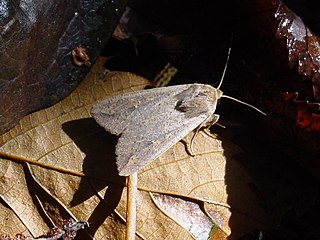
Mythimna unipuncta, the true armyworm moth, white-speck moth, common armyworm or rice armyworm, is a nocturnal agricultural pest belonging to the family Noctuidae. This moth is also commonly referred to by the scientific name Pseudaletia unipuncta. The species was first described by Adrian Hardy Haworth in 1809. Mythimna unipuncta is found in the Americas and in parts of Europe, Africa and Asia. Its original distribution is North and South America. It has been introduced to other places from there. They are known as armyworms because the caterpillars move in lines as a massive group, like an army, from field to field, damaging crops.

Coccinellidae is a widespread family of small beetles ranging in size from 0.8 to 18 mm. The family is commonly known as ladybugs in North America and ladybirds in Great Britain and other parts of the English-speaking world. Entomologists prefer the names ladybird beetles or lady beetles as these insects are not classified as true bugs.
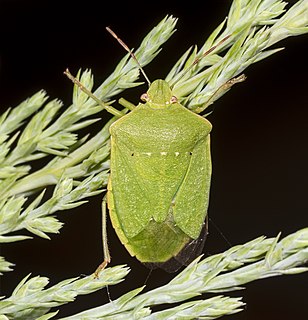
Nezara viridula, commonly known as the southern green stink bug (USA), southern green shield bug (UK) or green vegetable bug, is a plant-feeding stink bug. Believed to have originated in Ethiopia, it can now be found around the world. Because of its preference for certain species of legumes, such as beans and soybeans, it is an economically important pest on such crops.
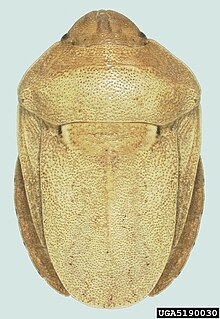
Eurygaster integriceps is a species of shield bug in the family Scutelleridae, commonly known as the sunn pest or corn bug. It is native to much of northern Africa, the Balkans and western and central Asia. It is a major pest of cereal crops especially wheat, barley and oats.
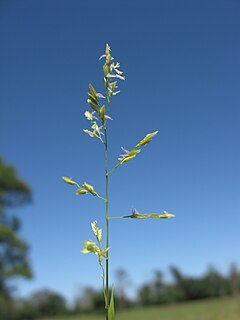
Leersia hexandra is a species of grass known by the common names southern cutgrass, clubhead cutgrass, and swamp rice grass. It has a pantropical distribution. It is also an introduced species in many regions, sometimes becoming invasive, and it is an agricultural weed of various crops, especially rice. It is also cultivated as a forage for livestock.

Liriomyza huidobrensis, commonly known as the pea leaf miner, is a species of insect, a fly in the family Agromyzidae. The larvae of this fly mine the leaves and stems of peas and a range of other vegetables. It is also known as the serpentine leaf miner, but this name is also used for a closely related species, Liriomyza brassicae.
Oxycarenus laetus, commonly known as the dusky cotton bug, is a species of plant bug belonging to the family Lygaeidae. It is sometimes known as the Egyptian cotton stainer, and is found in southern Asia where it is a pest of cotton, okra and other crops.

Leptocorisa acuta, the paddy earhead bug, is a species of bug recorded from northern Australia, Malesia and Taiwan. Its basionym is Cimex acutus and it is now placed in the family Alydidae. One of several rice bug species, it may be confused with Leptocorisa oratoria.
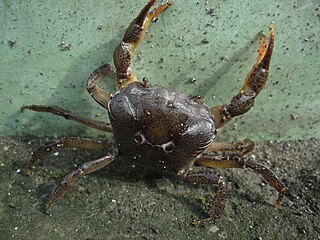
Parathelphusa convexa is a species of gecarcinucid crab. It is native to Java, and lives on rice paddies and rivers.


















